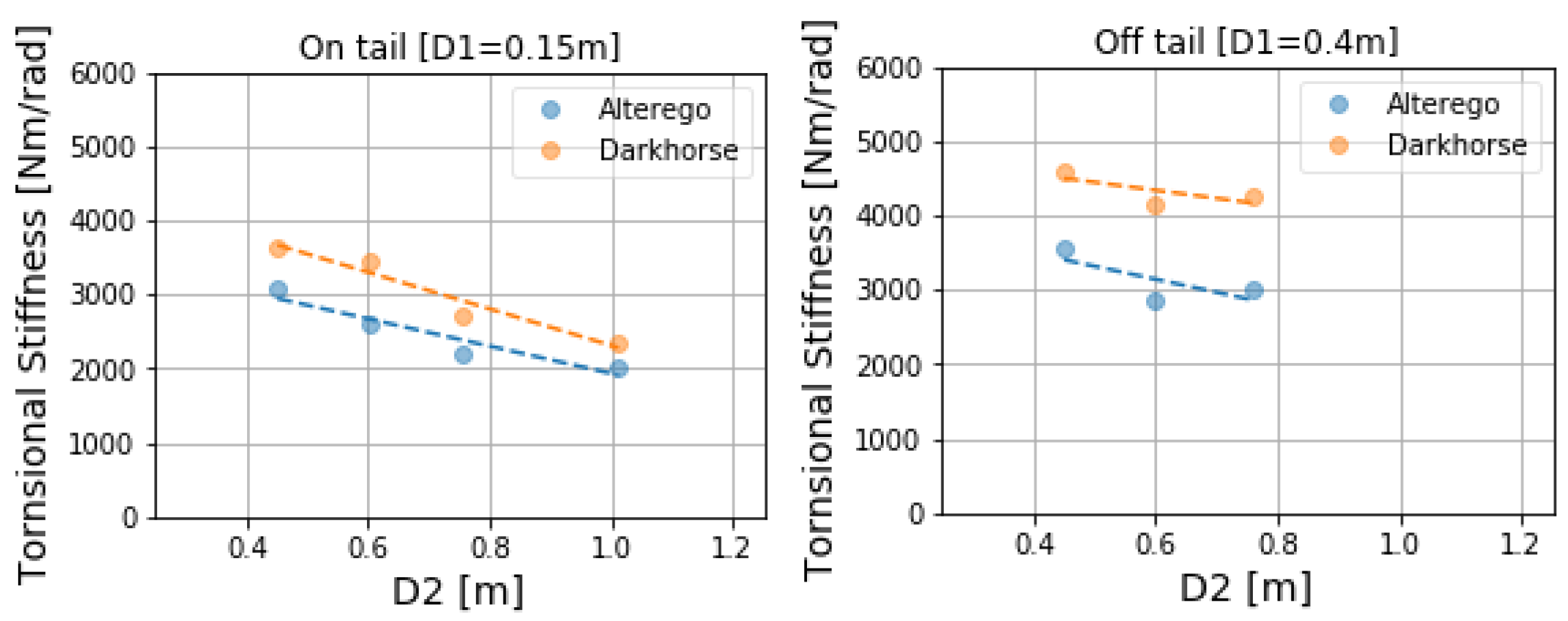Modern Surfboards and Their Structural Characterization: Towards an Engineering Approach †
Abstract
:1. Introduction
2. Methods
2.1. Surfboards
2.2. Tests
3. Results and Discussion
3.1. Torsional Stiffness
3.2. Weight Drop Test
3.3. Decay Tests
3.3.1. Nose Decay Test
3.3.2. Tail Decay Test
3.3.3. Free Decay Test
4. Conclusions
Funding
Acknowledgments
Conflicts of Interest
References
- Oggiano, L.; Pierella, F. CFD for Surfboards: Comparison between Three Different Designs in Static and Maneuvering Conditions. Multidiscip. Digit. Publ. Inst. Proc. 2018, 2, 309. [Google Scholar]
- Oggiano, L. Numerical Comparison between a Modern Surfboard and an Alaia Board using Computational Fluid Dynamics (CFD). icSPORTS 2017, 1, 75–82. [Google Scholar]
- Lavery, N.; Foster, G.; Carswell, N.; Brown, S. CFD modelling of the effect of fillets on fin drag. Reef J. 2009, 1, 93–111. [Google Scholar]
- Larsen, G.C.; Hansen, M.H.; Baumgart, A.; Carlén, I. Modal Analysis of Wind Turbine Blades; No. 1181(EN); Forskningscenter: Roskilde, Denmark, 2002. [Google Scholar]









| Board | Material | Length | Width | Thickness | Volume | Weight |
|---|---|---|---|---|---|---|
| (feet) | (inches) | (inches) | (L) | (kg) | ||
| Alterego | EPS with curvelinear cork stringers | 5.5 | 19 | 2.25 | 24.7 | 2.5 |
| Vessel | PU with wooden stringer | 5.5 | 19 | 2.25 | 25.8 | 3.1 |
| Model | On-Tail | Off-Tail | Surfer Stance | ||||||
|---|---|---|---|---|---|---|---|---|---|
| T | ± | n | ± | T | ± | n | ± | Stiff. Val. | |
| (Nm/rad) | - | - | - | (Nm/rad) | - | - | - | (Nm/rad) | |
| Alterego | 1985 | 99 | 0.47 | 0.05 | 2595 | 130 | 0.65 | 0.50 | 2215 |
| Darkhorse | 2375 | 119 | 0.57 | 0.58 | 3983 | 199 | 0.84 | 0.75 | 2699 |
| Alterego | Vessel Darkhorse | |||||
|---|---|---|---|---|---|---|
| Nose | Tail | Free | Nose | Tail | Free | |
| Damping Value | 14.2 | 15.7 | 5.4 | 8 | 10 | 3 |
| First Natural Frequency [Hz] | 19.2 | 5.2 | 64 | 20.4 | 19.2 | 102 |
| Critical Damping [%] | 8.2 | 3.1 | 1.42 | 4.4 | 1.8 | 1.52 |
Publisher’s Note: MDPI stays neutral with regard to jurisdictional claims in published maps and institutional affiliations. |
© 2020 by the authors. Licensee MDPI, Basel, Switzerland. This article is an open access article distributed under the terms and conditions of the Creative Commons Attribution (CC BY) license (https://creativecommons.org/licenses/by/4.0/).
Share and Cite
Oggiano, L.; Panhuis, M.i.h. Modern Surfboards and Their Structural Characterization: Towards an Engineering Approach. Proceedings 2020, 49, 65. https://doi.org/10.3390/proceedings2020049065
Oggiano L, Panhuis Mih. Modern Surfboards and Their Structural Characterization: Towards an Engineering Approach. Proceedings. 2020; 49(1):65. https://doi.org/10.3390/proceedings2020049065
Chicago/Turabian StyleOggiano, Luca, and Marc in het Panhuis. 2020. "Modern Surfboards and Their Structural Characterization: Towards an Engineering Approach" Proceedings 49, no. 1: 65. https://doi.org/10.3390/proceedings2020049065
APA StyleOggiano, L., & Panhuis, M. i. h. (2020). Modern Surfboards and Their Structural Characterization: Towards an Engineering Approach. Proceedings, 49(1), 65. https://doi.org/10.3390/proceedings2020049065






